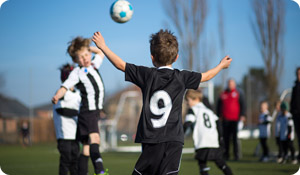
Kids don’t always play it safe: Whether they’re on the field or horsing around, adolescents and teens are more likely than adults to suffer head injuries. And the damage is often more severe, with long-term effects. But if you can recognize the signs of concussion, you’ll be able to help minimize the damage.
What Is a Concussion?
A concussion, also known as mild traumatic brain injury (mTBI), occurs when the brain is shaken, usually as a result of a blow or severe jolt to the head or body. Although sports equipment such as helmets and mouth guards can help prevent fracture, bleeding, and other impact injuries, they don’t seem to help reduce the incidence or severity of concussions.
Sports and recreation are a common cause of traumatic brain injury (including concussion) among children, teenagers, and young adults; according to the Centers for Disease Control and Prevention, US emergency departments (EDs) treat an estimated 173,285 of these injuries every year.
While most young people completely and quickly recover, occasionally symptoms can persist. Responsible adults can help prevent prolonged damage to a child’s brain by recognizing the symptoms of a concussion and taking appropriate action when one occurs.
Recognize the Symptoms
You may think of a concussion as a state of unconsciousness, but most children with mTBI do not actually pass out. A child with a concussion may simply appear shaky and confused. And while symptoms of a concussion may be apparent right after an accident, they may surface over the course of several hours or even several days.
Any of the following symptoms and behavioral changes could indicate a concussion:
- Loss of consciousness
- Slowness getting up from the ground
- Seizure
- Dazed or confused behavior
- Balance difficulties
- Slow reaction time
- Nausea and/or vomiting
- Drowsiness and/or fatigue
- Irritability
- Sadness and/or Depression
- Anxiety
- Emotional outbursts
- Memory lapses
- Headache and/or feeling of pressure in head
- Dizziness
- Blurred vision
- Sensitivity to light or sound
- Neck pain
- Difficulty concentrating
Take Action
If a child does incur a head injury, follow these guidelines:
- In the case of an obvious serious injury, call for help. Do not move the child or remove a helmet unless you are trained to do so in a medical emergency.
- If the head injury occurs during play, promptly take the child out of the game or practice for at least 24 hours to avoid further harm. A responsible adult should stay with the child and watch for symptoms of concussion, which may not appear for several hours. Symptoms can also worsen or change over time.
- If you suspect a concussion, even if symptoms appear to diminish, bring the child as soon as possible to a hospital emergency room, nearby medical center, or family physician. If necessary, call an ambulance or 911.
"Children with concussions should not return to playing a sport until all symptoms have resolved and they have been cleared by their doctor," warns Martin Osmond, MD, pediatric emergency physician at the Children’s Hospital of Eastern Ontario (CHEO) and Professor of Pediatrics at University of Ottawa.
What You Can Do: Arm Yourself With Information
In June 2014, the Ontario Neurotrauma Foundation, in collaboration with the CHEO, issued comprehensive guidelines for treating 5 to-18-year-olds who have sustained head injuries. The document can be accessed here.
Review the guidelines, which include a handy pocket guide for recognizing signs and symptoms of a concussion. You should also keep copies of the guidelines at home and in the car, and share them with schools, children’s sports facilities and recreational centers, and healthcare professionals. The more people who know how to recognize symptoms and respond to a concussion, the better.
Martin Osmond, MD, pediatric emergency physician at the Children’s Hospital of Eastern Ontario and Professor of Pediatrics, University of Ottawa, reviewed this article.
Sources
"Concussion in Sports and Play: Get the Facts.” Centers for Disease Control and Prevention. Page last updated October 6, 2011.
"Injury Prevention & Control: Traumatic Brain Injury." Centers for Disease Control and Prevention. Updated February 24, 2014; accessed July 14, 2014.
"Concussion Care for Kids: Minds Matter." The Children’s Hospital of Philadelphia. Page accessed July 14, 2014. http://www.chop.edu/service/concussion-care-for-kids/home.html
Harmon KG, Drezner JA, Gammons M, et al. "American Medical Society for Sports Medicine Position Statement: Concussion in Sport." Br J Sports Med 2013; 47:15-26.
"Heads Up: Concussion in Youth Sports." Centers for Disease Control and Prevention.





